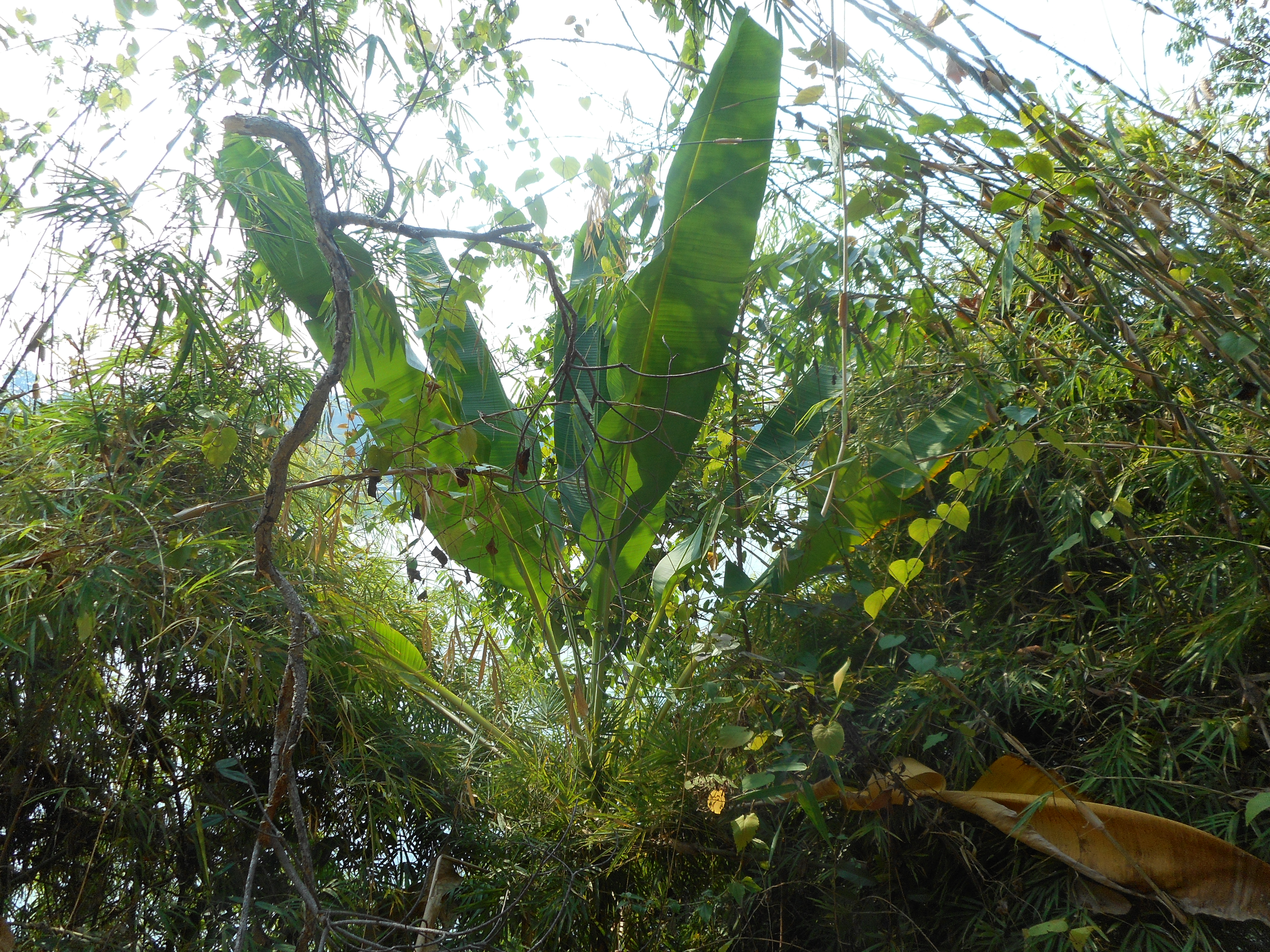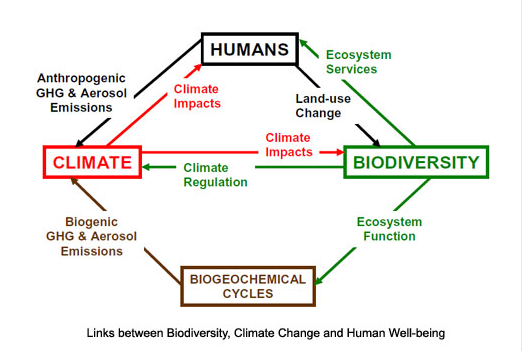Biodiversity or Biological Resources: Various organisms in the same or different species and living organisms of all levels and sources, including land, marine and freshwater ecosystems, and the ecological relationships in which these ecosystems exist.1 Biodiversity is essential for most of the resources used by humans, such as food, shelter and fuel. The Executive secretary of the Convention on Biological Diversity used the following definition:2
“Biological diversity underpins ecosystem functioning and the provision of ecosystem services essential for human wellbeing. It provides for food security, human health, the provision of clean air and water; it contributes to local livelihoods, and economic development…In addition it is a central component of many belief systems, worldviews and identities.”
Biodiversity is essential to anyone, despite not always being visible in cities, because it directly contributes to human wellbeing.3 The consequence of biodiversity loss are startling, and are being compared to those linked to climate change.4

Cambodian flora, Ratanakiri Province. Photo by Romeo Garreau, taken 30 April 2016.
Licensed under CC BY NC-ND 2.0.
Cambodia possesses some of the most valuable biodiversity in South East Asia. Its forests still hold (although in decreasing numbers) threatened species such as the Siamese crocodile and Asian elephant that are no longer found in the wild in neighboring countries.5
Biodiversity is not easy to assess, given there are different classifications measuring different variables, including species, ecosystems and genetic varieties, among many others.6
Ecosystems and species form a complex web of interaction. Weakening one at the benefit of another affects the balance. Professor Michel Loreau7 uses the example of a loss of a population of sea otters, which would lead to an increasing population of sea urchins, which would itself threaten a population of seaweed. This situation would lead to endangering species living within the seaweed ecosystem, while increasing coastal erosion that was prevented by seaweeds, a consequence directly affecting human life and livelihoods.
Species depend on their local environmental conditions for survival – what we refer to as ecological niches. When a given species experiences a change, that affects its surroundings. In general terms, the more species there are, the less important is the change caused by one species’ loss. The strongest ecosystems are the ones where there is a large biodiversity.
Any threat to biodiversity is a potential threat to people’s livelihoods and lifestyle sustainability. Although rarely recognized, it is of equal importance for rural people as are the impacts of industrial activities in the long-run.8
Much of Cambodia’s biodiversity is still being discovered at an extraordinary rate.
Between 1998 and 2011, the number of identified mammal species grew from 100 to 162, birds from 410 to 577, reptiles from 82 to 176, amphibians from 28 to 66, and fish from around 215 to 571 species.9 Seven new species were ‘discovered’ (described fully for the first time) in 2016 alone – a freshwater fish and six species of plants.10
It is highly likely that a large number of plant species still remain to be found. For example, 620 ferns have been identified in Thailand and 714 in Vietnam, yet only 217 in Cambodia so far. Cambodia also has many biodiversity hotspots – areas where there is not only wide biodiversity but also a significant number of species under threat. Data are not always consistent. IUCN established a list of known species in Cambodia in 2010.11
Taxon | Total known species | On IUCN Red List as endangered, threatened, or vulnerable |
Mammal species | 123 | 37 |
Bird species | 545 | 36 |
Fish species | 874 | N/A |
Reptile species | 88 | 13 |
Amphibians | 63 | 12 |
Vascular plant species | 2,308 | 38 |
Hard coral | 24 | N/A |
Soft coral | 14 | N/A |
Sea grass | 10 | N/A |
The major threats for biodiversity in Cambodia are:12
- Land conversion/deforestation
- Dams, roads and infrastructure including coastal development
- Sand dredging in waterways
- Overfishing and illegal fishing techniques
- Illegal harvest of forest products
- Illegal wildlife trade.13
Apart from strict environmental protection, working for poverty reduction is one of approaches that can be taken to lower environmental pressures.14 Stresses on livelihoods are partly caused by environmental resource degradation. Livelihood coping strategies vary depending on the household’s income – the more income, the less vulnerability to environmental variations. High-return activities allow farmers to use less land. Rural livelihoods in general may switch towards off-farm activities in order to reduce environmental exploitation, an approach that can be encouraged through education or social networking.
Although threatened, biodiversity protection is addressed by the Royal Government of Cambodia, diverse NGOs and local communities. Part of their work will be focused on the biodiversity elements in two of the United Nations Sustainable Development Goals: Goal 14 Life below water and Goal 15 Life on land.
NGOs’ biodiversity programs
Some areas of important biodiversity have legal protection, such as Mondulkiri’s Seima Biodiversity Conservation Area and the Central Cardamom Mountains Protected Forest.
Apart from the legal structures of protected areas, a common protection means is an agreement signed between the Royal Government of Cambodia and NGOs to implement specific projects for nature protection.
Other important areas such as Prey Lang – the largest lowland evergreen forest in Cambodia, and one of the largest in the Indo-Burma region – gained protection only recently. Prey Lang stretches over four provinces – Kratie, Kampong Thom, Stung Treng and Preah Vihear.
Cambodia is especially rich in forestry resources, although deforestation remains a threat.15 Regarding forestry, ecological classification is different from legal forest classification. In Cambodia, forests are, along with coastal areas and rivers and lakes, the main reservoir of biodiversity.
The Royal Government of Cambodia and Wildlife Conservation Society signed a project agreement in 2016 to use US$ 2.6 million generated through a carbon credit trade involving the Disney company. This money will be used for conservation purposes in Keo Seima Wildlife Sanctuary. Carbon credits are a potential source of finance for conservation in Cambodia.16
Governmental biodiversity policy
Biodiversity protection is addressed in many ways by the Royal Government of Cambodia.
On February 1995, Cambodia signed the Convention on Biological Diversity. In 1997, the Convention on International Trade in Endangered Species of Wild Fauna and Flora (CITES) was ratified, followed the same year by the development of the National Biodiversity Strategy and Action Plan.17
This opened the way to the National Environment Action Plan 1998–2002,18 addressing four issues:
- Threats to biodiversity in Cambodia
- Gaps in the existing protected areas
- Legal and institutional arrangements for managing protected areas
- Strategies for biodiversity conservation
In June 2009, the Royal Government of Cambodia signed an agreement with Terra Global Capital, a technical support/ecosystem services brokering company. The hope is that the agreement will reduce deforestation, thus reducing carbon dioxide emissions by 8.5 million tons in the course of 30 years. Resulting from this agreement, there are now 13 community forest tracts in Oddar Meanchey and one in Mondulkiri Province that are being managed as pilot REDD+ carbon-offset projects.
Steps are being taken to make environmental policy more comprehensive. The 2008 Law on Protected Areas replaced a previous one from 1993, with more specific guidelines. An environmental code is currently being drafted and should better match international standards, as well as ensuring better environmental protection.
The protection of biodiversity is specifically addressed in both of the government’s key guiding development policy documents, the Rectangular Strategy Phase III and the National Strategic Development Plan 2014–2018. Both talk about biodiversity in the context of striking a balance between development and conservation.1920
A lack of enough people skilled in conservation management has been identified and is being addressed in a number of ways. For example, at the Royal University of Phnom Penh, the Centre for Biodiversity Conservation trains and supports Cambodian scientists.21
The industry’s responsibility over biodiversity is also addressed. The developing Environmental Impact Assessment concept encompasses biodiversity issues.
Last updated: 05 December 2017
Related to biodiversity
References
- 1. Lexicon of “Law on Protected Areas 2008”. Accessed on 05 December 2017. https://opendevelopmentcambodia.net/dataset/?id=5f94811e-f6fa-4a25-b73f-2271aaf6a096
- 2. Strategic Plan for Biodiversity 2011–2020 and the Aichi Targets, Secretariat for the Convention on Biodiversity, Mr. Braulio F. De Souza Dias UNEP. April 2016. Accessed 23 August 2016. https://www.cbd.int/doc/speech/2016/sp-2016-04-04-chm-workshop-rs-en.pdf
- 3. M. Dallimer, K. Irvine, A. Skinner, Z. Davies, J. Rouquette, L. Maltby, P. Warren, P. Armsworth, K. Gaston. (2012). “Biodiversity and the Feel-Good Factor: Understanding Associations between Self-Reported Human Well-being and Species Richness “. American Institute of Biological Sciences. Accessed 23 August 2016. http://bioscience.oxfordjournals.org/content/62/1/47.full
- 4. B. Cardinale, J. Duffy, A. Gonzalez, D. Hooper, C. Perrings, P. Venail, A. Narwani, G. Mace, D. Tilman, D. Wardle, A. Kinzig, G. Daily, M. Loreau, J. Grace, A. Larigauderie, D. Srivastava, S. Naeem. (2012). “Biodiversity loss and its impact on humanity”. School of Natural Resources and Environment. Accessed 24 August 2016. http://snre.umich.edu/cardinale/wp-content/uploads/2012/04/Cardinale-et-al-Nature-2012.pdf
- 5. Fauna & Flora International (FFI). Accessed 5 July 2015. http://www.fauna-flora.org/explore/cambodia/
- 6. Harold Levrel. (2007). « Quels indicateurs pour la gestion de la biodiversite” Institut Français de la Biodiversite. Accessed 5 May 2016. http://temis.documentation.developpement-durable.gouv.fr/documents/Temis/0066/Temis-0066100/18350.pdf
- 7. Michel Loreau. Unspecified date. “The ecological consequences of biodiversity loss”. Department of Biology, McGill University. Accessed 24 August 2016. http://www.interacademies.net/File.aspx?id=10351
- 8. Greenfacts. (2005). “Biodiversity & Human Well-being”. Accessed 24 August 2016. http://www.greenfacts.org/en/biodiversity/
- 9. J. Daltry. (2011). “Finders, keepers”. Cambodian Journal of Natural History.
- 10. Alessandro Marazzi Sassoon 2017. “Seven new species discovered in Cambodia last year”, The Phnom Penh Post, 19 December 2017. http://www.phnompenhpost.com/national/seven-new-species-discovered-cambodia-last-year Accessed 29 December 2017.
- 11. International Union for Conservation of Nature and Natural Resources (IUCN). “The IUCN red list of threatened species.” Accessed 23 August 2016. http://www.iucnredlist.org/
- 12. World Wildlife Funds. (2010). “Threats to Cambodia Biodiversity”. Accessed 22 August 2016. http://www.assets.panda.org/…/threats_and_solutions_wed_posters__eng.pdf
- 13. Khoun Theara. “Wildlife trade endangering Cambodia’s Fauna”. Voice of America Cambodia, 23 June 2014. Accessed 24 August 2016. http://www.voacambodia.com/a/wildlife-trade-endangering-cambodias-fauna/1943063.html
- 14. T. Nguyen, D. Truong, D. Bühlera, R. Hartjea, U. Grote. (2015). ”Rural livelihoods and environmental resource dependence in Cambodia”, Institute for Environmental Economics and World Trade. Accessed 23 August 2016. http://www.sciencedirect.com/science/article/pii/S0921800915004322
- 15. Phak Seangly. “Four charged over forest clearing”. The Phnom Penh Post, 20 January 2014. Accessed 24 August 2016. http://www.phnompenhpost.com/national/four-charged-over-forest-clearing
- 16. Safiya Charles. “Carbon credits the start: Minister”. Khmer Times, 12 August 2016. Accessed 24 August 2016. http://www.khmertimeskh.com/news/28420/carbon-credits-the-start–minister/
- 17. Royal Government of Cambodia. (2002). “National Biodiversity Strategy and Action Plan”. Accessed 05 May 2016. https://www.cbd.int/doc/world/kh/kh-nbsap-01-en.pdf
- 18. Pisey Oum. “Biodiversity Planning in Asia”. International Centre for Environmental Management. Accessed 5 May 2016. http://www.icem.com.au/documents/biodiversity/bioplan/cambodia.pdf
- 19. Royal Government of Cambodia. (2013). Rectangular Strategy Phase III. Accessed 5 July 2015. http://www.cambodiainvestment.gov.kh/2013-rectangular-strategy-phase-iii.html
- 20. Ministry of Planning of Cambodia. National Strategy Development Plan 2014–2018. https://opendevelopmentcambodia.net/dataset/?id=national-strategic-development-plan-2014-2018
- 21. Ibid


